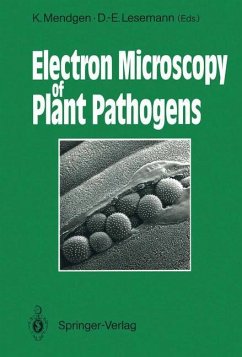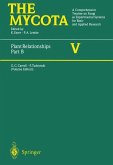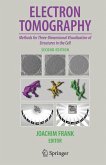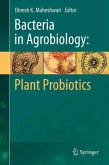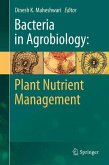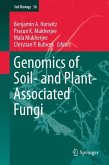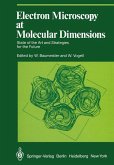Electron Microscopy of Plant Pathogens
Herausgegeben von Mendgen, Kurt; Lesemann, Dietrich-Eckhardt
Electron Microscopy of Plant Pathogens
Herausgegeben von Mendgen, Kurt; Lesemann, Dietrich-Eckhardt
- Broschiertes Buch
- Merkliste
- Auf die Merkliste
- Bewerten Bewerten
- Teilen
- Produkt teilen
- Produkterinnerung
- Produkterinnerung
Plants, fungi, and viruses were among the first biological objects studied with an electron microscope. One of the two first instruments built by Siemens was used by Helmut Ruska, a brother of Ernst Ruska, the pioneer in constructing electron microscopes. H. Ruska published numerous papers on different biological objects in 1939. In one of these, the pictures by G. A. Kausche, E. Pfankuch, and H. Ruska of tobacco mosaic virus opened a new age in microscopy. The main problem was then as it still is today, to obtain an appropriate preparation of the specimen for observation in the electron…mehr
Andere Kunden interessierten sich auch für
![Plant Relationships Part B Plant Relationships Part B]() Plant Relationships Part B74,99 €
Plant Relationships Part B74,99 €![Microbial Megaplasmids Microbial Megaplasmids]() Microbial Megaplasmids110,99 €
Microbial Megaplasmids110,99 €![Electron Tomography Electron Tomography]() FrankElectron Tomography177,99 €
FrankElectron Tomography177,99 €![Bacteria in Agrobiology: Plant Probiotics Bacteria in Agrobiology: Plant Probiotics]() Bacteria in Agrobiology: Plant Probiotics110,99 €
Bacteria in Agrobiology: Plant Probiotics110,99 €![Bacteria in Agrobiology: Plant Nutrient Management Bacteria in Agrobiology: Plant Nutrient Management]() Bacteria in Agrobiology: Plant Nutrient Management147,99 €
Bacteria in Agrobiology: Plant Nutrient Management147,99 €![Genomics of Soil- and Plant-Associated Fungi Genomics of Soil- and Plant-Associated Fungi]() Genomics of Soil- and Plant-Associated Fungi110,99 €
Genomics of Soil- and Plant-Associated Fungi110,99 €![Electron Microscopy at Molecular Dimensions Electron Microscopy at Molecular Dimensions]() Electron Microscopy at Molecular Dimensions77,99 €
Electron Microscopy at Molecular Dimensions77,99 €-
-
-
Plants, fungi, and viruses were among the first biological objects studied with an electron microscope. One of the two first instruments built by Siemens was used by Helmut Ruska, a brother of Ernst Ruska, the pioneer in constructing electron microscopes. H. Ruska published numerous papers on different biological objects in 1939. In one of these, the pictures by G. A. Kausche, E. Pfankuch, and H. Ruska of tobacco mosaic virus opened a new age in microscopy. The main problem was then as it still is today, to obtain an appropriate preparation of the specimen for observation in the electron microscope. Beam damage and specimen thickness were the first obstacles to be met. L. Marton in Brussels not only built his own instrument, but also made considerable progress in specimen preparation by introducing the impregnation of samples with heavy metals to obtain useful contrast. His pictures of the bird nest orchid root impregnated with osmium were revolutionary when published in 1934. Itis not the place here to recall the different techniques which were developed in the subsequent years to attain the modern knowledge on the fine structure of plant cells and of different plant pathogens. The tremendous progress obtained with tobacco mosaic virus is reflected in the chapter by M. Wurtz on the fine structure of viruses in this Volume. New cytochemical and immunological techniques considerably surpass the morphological information obtained from the pathogens, especially at the host-parasite interface.
Produktdetails
- Produktdetails
- Verlag: Springer / Springer Berlin Heidelberg / Springer, Berlin
- Artikelnr. des Verlages: 978-3-642-75820-1
- Softcover reprint of the original 1st ed. 1991
- Seitenzahl: 356
- Erscheinungstermin: 27. Dezember 2011
- Englisch
- Abmessung: 242mm x 170mm x 20mm
- Gewicht: 610g
- ISBN-13: 9783642758201
- ISBN-10: 3642758207
- Artikelnr.: 36121904
- Verlag: Springer / Springer Berlin Heidelberg / Springer, Berlin
- Artikelnr. des Verlages: 978-3-642-75820-1
- Softcover reprint of the original 1st ed. 1991
- Seitenzahl: 356
- Erscheinungstermin: 27. Dezember 2011
- Englisch
- Abmessung: 242mm x 170mm x 20mm
- Gewicht: 610g
- ISBN-13: 9783642758201
- ISBN-10: 3642758207
- Artikelnr.: 36121904
1 Preservation of Cell Ultrastructure by Freeze-Substitution.- 1 Introduction.- 2 The Cryofixed Cell.- 3 Freezing Methods.- 4 Specimen Preparation.- 5 Substitution.- 6 Problems and Artifacts Associated with Freeze-Substitution.- 7 Conclusions.- References.- 2 Low-Temperature Scanning Electron Microscopy of Fungi and Fungus-Plant Interactions.- 1 Introduction.- 2 Specimen Preparation.- 3 Rapid Immobilization and Stabilization.- 4 Retention of Water.- 5 No Exposure to Chemicals, Fixatives or Solvents.- 6 Artifacts Specific to Low-Temperature Scanning Electron Microscopy.- 7 Future Developments.- References.- 3 High Pressure Freezing of Rust Infected Plant Leaves.- 1 Introduction.- 2 The Specimen Sandwich.- 3 Plunge Freezing vs. High Pressure Freezing.- 4 Infiltration of Leaves.- 5 Freeze-Substitution and Embedding.- 6 A Re-Evaluation of the Haustorial Host-Parasite Interface..- 7 Conclusions.- References.- 4 Cytochemistry of Fungal Surfaces: Carbohydrate Containing Molecules.- 1 Introduction.- 2 EM Probes for External Carbohydrates.- 3 EM Methods.- 4 Conclusion.- References.- 5 Analytical Electron Microscopy in Plant Pathology: X-Ray Microanalysis and Energy Loss Spectroscopy.- 1 Introduction.- 2 XRMA Principles.- 3 XRMA Detectors.- 4 Applications to Plant Pathology-XRMA.- 5 Electron Energy Loss Spectrometry (EELS) Principles.- 6 EEL Spectrometer Systems.- 7 Applications to Plant Pathology-EELS.- 8 Summary.- References.- 6 The Fine Structure of Virus Particles.- 1 Introduction.- 2 Spherical Plant Viruses.- 3 Rod-Shaped Plant Viruses.- 4 Filamentous Plant Virus.- 5 Discussion.- 6 Conclusion.- References.- 7 Immunoelectron Microscopy for Virus Identification.- 1 Introduction.- 2 Leaf-Dip Serology.- 3 Immune Complexes from Ouchterlony Plates.- 4 ISEM.- 5 Decoration.- 6 Mycoplasma-Like Organisms.- 7 Conclusion.- References.- 8 Cytochemistry of Virus-Infected Plant Cells.- 1 Introduction.- 2 Light Microscopy.- 3 Electron Microscopy.- 4 Concluding Remarks.- References.- 9 Immunolabeling of Viral Antigens in Infected Cells.- 1 Introduction.- 2 Labeling.- 3 Initial Interaction.- 4 Site of Coat Protein Synthesis/Virus Assembly.- 5 Translocation of CCMV Genome.- 6 Detection of RNA.- References.- 10 Mechanisms of Plant Virus Transmission by Homopteran Insects.- 1 Introduction.- 2 The Role of EM in the Elucidation of Transmission Mechanisms.- 3 Studies on Insect Structures Involved in Transmission.- 4 Special Problems in Studying Virus-Vector Relations by EM.- References.- 11 Specific Cytological Alterations in Virus-Infected Plant Cells.- 1 Introduction.- 2 Viral Genome Products as Infection-Specific Constituents of Cells.- 3 Virus-Specific Alterations of the Cellular Membrane System.- 4 Conclusions.- References.- 12 Structure, Cellular Location, and Cytopathology of Viroids.- 1 Introduction.- 2 Structure and Structural Transitions of Viroids.- 3 Complexes of Viroids and Polymerase.- 4 Intracellular Location.- 5 Prospects.- References.- 13 Immunological Detection and Localization of Mycoplasma-Like Organisms (MLOs) in Plants and Insects by Light and Electron Microscopy.- 1 Introduction.- 2 In Vitro Methods.- 3 In Situ Methods.- References.- 14 Interactions Between Pseudomonas and Phaseolus vulgaris.- 1 Introduction.- 2 The Saprophyte.- 3 The Hypersensitive Reaction.- 4 The Compatible Interaction.- 5 Quantitative Analysis Using Transconjugants.- 6 Concluding Remarks.- References.- 15 The Fate of Peripheral Vesicles in Zoospores of Phytophthora cinnamomi During Infection of Plants.- 1 Introduction.- 2 Peripheral Vesicles in Phytophthora cinnamomi Zoospores.- 3 Exocytosis of Peripheral Vesicles During Encystment.- 4 Fate of the Large Peripheral Vesicles.- 5 Roles of Peripheral Vesicles During Encystment.- References.- 16 Hemibiotrophy in Colletotrichum lindemuthianum.- 1 Introduction.- 2 Initial Penetration of Epidermal Cells.- 3 Intracellular Bio trophic Phase.- 4 The Host-Parasite Interface.- 5 Necrotrophic Phase.- 6 Basis of Nutritional Shifts.- 7 Hemibiotrophy in Other Colletotrichum Species.- 8 Conclusions.- References.- 17 Extracellular Materials of Fungal Structures: Their Significance at Prepenetration Stages of Infection.- 1 Introduction.- 2 Fungal Adhesion to Substrata.- 3 Mechanism of Secretion of Extracellular Materials From Fungal Structures.- 4 Significance of Extracellular Materials in Fungal Infection.- References.- 18 Rust Haustoria.- 1 Introduction.- 2 Host Cell Penetration.- 3 The Neck Ring.- 4 The Extrahaustorial Matrix.- 5 The Extrahaustorial Membrane and Associated Host Membranes.- 6 Physiology and Function.- References.- 19 Infection by Magnaporthe: An In Vitro Analysis.- 1 Introduction.- 2 Attachment of Conidia.- 3 Appressorium Formation.- 4 Melanization 4.- 5 Invasive Structures.- 6 Mechanism of Penetration.- 7 Appressorium Function.- 8 Conclusions.- References.- 20 Mycorrhizal and Pathogenic Fungi: Do They Share Any Features?.- 1 Introduction.- 2 The Infection Process.- 3 Adjustment of the Fungal Cell Surface.- 4 Host Responses: The Interface Zone.- 5 Host Responses: The Defence Reactions.- 6 Conclusions and Speculations.- References.- 21 Haustoria-Like Structures and Hydrophobic Cell Wall Surface Layers in Lichens.- 1 Lichen Mycobionts and Photobionts.- 2 The Lichen Symbiosis.- 3 Physiological Aspects of the Lichen Symbiosis.- 4 Fine Structure of the Mycobiont-Photobiont Interface.- 5 The Functional Morphology of the Mycobiont-Photobiont Interface.- References.- 22 Ultrastructure of Nematode-Plant Interactions.- 1 Introduction.- 2 The Sensory System of Nematodes.- 3 Host Reactions with Ectoparasitic Species.- 4 Host Reactions with Endoparasitic Species.- 5 Feeding Site Adaptations.- 6 Nematodes as Virus Vectors.- 7 Conclusion.- References.- 23 Infection of Plants by Flagellate Protozoa (Phytomonas SPP., Trypanosomatidae).- 1 Introduction.- 2 Phloem Restricted Phytomonas.- 3 Milkweed Phytomonas.- 4 Characterization of Phytomonas.- References.- 24 Influence of Fungicides on Fungal Fine Structure.- 1 Introduction.- 2 Carboxamides: Inhibition of Respiration Processes.- 3 Aromatic Hydrocarbons and Dicarboximides: Lipid Peroxidation.- 4 Polyoxin: Chitin Synthesis Inhibition.- 5 Sterol-Biosynthesis-Inhibiting Fungicides.- 6 2-Aminopyrimidines: Inhibition of Purine Metabolism.- 7 Benzimidazoles: Inhibition of Microtubal Assembly.- 8 Tricylazole: Inhibition of the Melanin Biosynthesis.- 9 Acylalanines: Inhibition of rRNA Synthesis.- 10 Nonfungicidal Disease Control Agents.- 11 Dichlorocyclopropane: Action on Host-Resistance Mechanisms.- 12 Conclusion.- References.
1 Preservation of Cell Ultrastructure by Freeze-Substitution.- 1 Introduction.- 2 The Cryofixed Cell.- 3 Freezing Methods.- 4 Specimen Preparation.- 5 Substitution.- 6 Problems and Artifacts Associated with Freeze-Substitution.- 7 Conclusions.- References.- 2 Low-Temperature Scanning Electron Microscopy of Fungi and Fungus-Plant Interactions.- 1 Introduction.- 2 Specimen Preparation.- 3 Rapid Immobilization and Stabilization.- 4 Retention of Water.- 5 No Exposure to Chemicals, Fixatives or Solvents.- 6 Artifacts Specific to Low-Temperature Scanning Electron Microscopy.- 7 Future Developments.- References.- 3 High Pressure Freezing of Rust Infected Plant Leaves.- 1 Introduction.- 2 The Specimen Sandwich.- 3 Plunge Freezing vs. High Pressure Freezing.- 4 Infiltration of Leaves.- 5 Freeze-Substitution and Embedding.- 6 A Re-Evaluation of the Haustorial Host-Parasite Interface..- 7 Conclusions.- References.- 4 Cytochemistry of Fungal Surfaces: Carbohydrate Containing Molecules.- 1 Introduction.- 2 EM Probes for External Carbohydrates.- 3 EM Methods.- 4 Conclusion.- References.- 5 Analytical Electron Microscopy in Plant Pathology: X-Ray Microanalysis and Energy Loss Spectroscopy.- 1 Introduction.- 2 XRMA Principles.- 3 XRMA Detectors.- 4 Applications to Plant Pathology-XRMA.- 5 Electron Energy Loss Spectrometry (EELS) Principles.- 6 EEL Spectrometer Systems.- 7 Applications to Plant Pathology-EELS.- 8 Summary.- References.- 6 The Fine Structure of Virus Particles.- 1 Introduction.- 2 Spherical Plant Viruses.- 3 Rod-Shaped Plant Viruses.- 4 Filamentous Plant Virus.- 5 Discussion.- 6 Conclusion.- References.- 7 Immunoelectron Microscopy for Virus Identification.- 1 Introduction.- 2 Leaf-Dip Serology.- 3 Immune Complexes from Ouchterlony Plates.- 4 ISEM.- 5 Decoration.- 6 Mycoplasma-Like Organisms.- 7 Conclusion.- References.- 8 Cytochemistry of Virus-Infected Plant Cells.- 1 Introduction.- 2 Light Microscopy.- 3 Electron Microscopy.- 4 Concluding Remarks.- References.- 9 Immunolabeling of Viral Antigens in Infected Cells.- 1 Introduction.- 2 Labeling.- 3 Initial Interaction.- 4 Site of Coat Protein Synthesis/Virus Assembly.- 5 Translocation of CCMV Genome.- 6 Detection of RNA.- References.- 10 Mechanisms of Plant Virus Transmission by Homopteran Insects.- 1 Introduction.- 2 The Role of EM in the Elucidation of Transmission Mechanisms.- 3 Studies on Insect Structures Involved in Transmission.- 4 Special Problems in Studying Virus-Vector Relations by EM.- References.- 11 Specific Cytological Alterations in Virus-Infected Plant Cells.- 1 Introduction.- 2 Viral Genome Products as Infection-Specific Constituents of Cells.- 3 Virus-Specific Alterations of the Cellular Membrane System.- 4 Conclusions.- References.- 12 Structure, Cellular Location, and Cytopathology of Viroids.- 1 Introduction.- 2 Structure and Structural Transitions of Viroids.- 3 Complexes of Viroids and Polymerase.- 4 Intracellular Location.- 5 Prospects.- References.- 13 Immunological Detection and Localization of Mycoplasma-Like Organisms (MLOs) in Plants and Insects by Light and Electron Microscopy.- 1 Introduction.- 2 In Vitro Methods.- 3 In Situ Methods.- References.- 14 Interactions Between Pseudomonas and Phaseolus vulgaris.- 1 Introduction.- 2 The Saprophyte.- 3 The Hypersensitive Reaction.- 4 The Compatible Interaction.- 5 Quantitative Analysis Using Transconjugants.- 6 Concluding Remarks.- References.- 15 The Fate of Peripheral Vesicles in Zoospores of Phytophthora cinnamomi During Infection of Plants.- 1 Introduction.- 2 Peripheral Vesicles in Phytophthora cinnamomi Zoospores.- 3 Exocytosis of Peripheral Vesicles During Encystment.- 4 Fate of the Large Peripheral Vesicles.- 5 Roles of Peripheral Vesicles During Encystment.- References.- 16 Hemibiotrophy in Colletotrichum lindemuthianum.- 1 Introduction.- 2 Initial Penetration of Epidermal Cells.- 3 Intracellular Bio trophic Phase.- 4 The Host-Parasite Interface.- 5 Necrotrophic Phase.- 6 Basis of Nutritional Shifts.- 7 Hemibiotrophy in Other Colletotrichum Species.- 8 Conclusions.- References.- 17 Extracellular Materials of Fungal Structures: Their Significance at Prepenetration Stages of Infection.- 1 Introduction.- 2 Fungal Adhesion to Substrata.- 3 Mechanism of Secretion of Extracellular Materials From Fungal Structures.- 4 Significance of Extracellular Materials in Fungal Infection.- References.- 18 Rust Haustoria.- 1 Introduction.- 2 Host Cell Penetration.- 3 The Neck Ring.- 4 The Extrahaustorial Matrix.- 5 The Extrahaustorial Membrane and Associated Host Membranes.- 6 Physiology and Function.- References.- 19 Infection by Magnaporthe: An In Vitro Analysis.- 1 Introduction.- 2 Attachment of Conidia.- 3 Appressorium Formation.- 4 Melanization 4.- 5 Invasive Structures.- 6 Mechanism of Penetration.- 7 Appressorium Function.- 8 Conclusions.- References.- 20 Mycorrhizal and Pathogenic Fungi: Do They Share Any Features?.- 1 Introduction.- 2 The Infection Process.- 3 Adjustment of the Fungal Cell Surface.- 4 Host Responses: The Interface Zone.- 5 Host Responses: The Defence Reactions.- 6 Conclusions and Speculations.- References.- 21 Haustoria-Like Structures and Hydrophobic Cell Wall Surface Layers in Lichens.- 1 Lichen Mycobionts and Photobionts.- 2 The Lichen Symbiosis.- 3 Physiological Aspects of the Lichen Symbiosis.- 4 Fine Structure of the Mycobiont-Photobiont Interface.- 5 The Functional Morphology of the Mycobiont-Photobiont Interface.- References.- 22 Ultrastructure of Nematode-Plant Interactions.- 1 Introduction.- 2 The Sensory System of Nematodes.- 3 Host Reactions with Ectoparasitic Species.- 4 Host Reactions with Endoparasitic Species.- 5 Feeding Site Adaptations.- 6 Nematodes as Virus Vectors.- 7 Conclusion.- References.- 23 Infection of Plants by Flagellate Protozoa (Phytomonas SPP., Trypanosomatidae).- 1 Introduction.- 2 Phloem Restricted Phytomonas.- 3 Milkweed Phytomonas.- 4 Characterization of Phytomonas.- References.- 24 Influence of Fungicides on Fungal Fine Structure.- 1 Introduction.- 2 Carboxamides: Inhibition of Respiration Processes.- 3 Aromatic Hydrocarbons and Dicarboximides: Lipid Peroxidation.- 4 Polyoxin: Chitin Synthesis Inhibition.- 5 Sterol-Biosynthesis-Inhibiting Fungicides.- 6 2-Aminopyrimidines: Inhibition of Purine Metabolism.- 7 Benzimidazoles: Inhibition of Microtubal Assembly.- 8 Tricylazole: Inhibition of the Melanin Biosynthesis.- 9 Acylalanines: Inhibition of rRNA Synthesis.- 10 Nonfungicidal Disease Control Agents.- 11 Dichlorocyclopropane: Action on Host-Resistance Mechanisms.- 12 Conclusion.- References.

